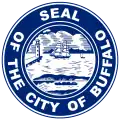Buffalo Metro Rail
Buffalo Metro Rail is the public transit rail system in Buffalo, New York, operated by the Niagara Frontier Transportation Authority (NFTA). The system consists of a single, 6.4-mile-long (10.3 km) light rail line that runs for most of the length of Main Street (New York State Route 5) from KeyBank Center in Canalside to the south campus of the University at Buffalo in the northeast corner of the city. The first section of the line opened in October 1984; the current system was completed in November 1986. In 2022, the system had a ridership of 2,386,400, or about 8,600 per weekday as of the second quarter of 2023.
| Metro Rail | ||||||||||||||||||||||||||||||||||||||||||||||||||||||||||||||||||||||||||||||||||||||||||||||||||||||||||||||||||||||||||||||||||||||||||||||||||||||||||||||||||||||||||||||||||||||||||||||||||||||||||||||||||||||||||||||||||||||||||||||||||||||||||||||||||||||||||||||||||||||||||||||||||||||||||||||||||||||||||||||||||||||||||||||||||||||||||||||||||||||||||||||||||||||||||||||||||
|---|---|---|---|---|---|---|---|---|---|---|---|---|---|---|---|---|---|---|---|---|---|---|---|---|---|---|---|---|---|---|---|---|---|---|---|---|---|---|---|---|---|---|---|---|---|---|---|---|---|---|---|---|---|---|---|---|---|---|---|---|---|---|---|---|---|---|---|---|---|---|---|---|---|---|---|---|---|---|---|---|---|---|---|---|---|---|---|---|---|---|---|---|---|---|---|---|---|---|---|---|---|---|---|---|---|---|---|---|---|---|---|---|---|---|---|---|---|---|---|---|---|---|---|---|---|---|---|---|---|---|---|---|---|---|---|---|---|---|---|---|---|---|---|---|---|---|---|---|---|---|---|---|---|---|---|---|---|---|---|---|---|---|---|---|---|---|---|---|---|---|---|---|---|---|---|---|---|---|---|---|---|---|---|---|---|---|---|---|---|---|---|---|---|---|---|---|---|---|---|---|---|---|---|---|---|---|---|---|---|---|---|---|---|---|---|---|---|---|---|---|---|---|---|---|---|---|---|---|---|---|---|---|---|---|---|---|---|---|---|---|---|---|---|---|---|---|---|---|---|---|---|---|---|---|---|---|---|---|---|---|---|---|---|---|---|---|---|---|---|---|---|---|---|---|---|---|---|---|---|---|---|---|---|---|---|---|---|---|---|---|---|---|---|---|---|---|---|---|---|---|---|---|---|---|---|---|---|---|---|---|---|---|---|---|---|---|---|---|---|---|---|---|---|---|---|---|---|---|---|---|---|---|---|---|---|---|---|---|---|---|---|---|---|---|---|---|---|---|---|---|---|---|---|---|---|---|---|---|---|---|---|---|---|---|---|---|---|---|---|---|---|---|---|---|---|---|---|---|---|---|---|---|---|---|---|---|
 | ||||||||||||||||||||||||||||||||||||||||||||||||||||||||||||||||||||||||||||||||||||||||||||||||||||||||||||||||||||||||||||||||||||||||||||||||||||||||||||||||||||||||||||||||||||||||||||||||||||||||||||||||||||||||||||||||||||||||||||||||||||||||||||||||||||||||||||||||||||||||||||||||||||||||||||||||||||||||||||||||||||||||||||||||||||||||||||||||||||||||||||||||||||||||||||||||||
.jpg.webp) Two typical trains at Fountain Plaza station | ||||||||||||||||||||||||||||||||||||||||||||||||||||||||||||||||||||||||||||||||||||||||||||||||||||||||||||||||||||||||||||||||||||||||||||||||||||||||||||||||||||||||||||||||||||||||||||||||||||||||||||||||||||||||||||||||||||||||||||||||||||||||||||||||||||||||||||||||||||||||||||||||||||||||||||||||||||||||||||||||||||||||||||||||||||||||||||||||||||||||||||||||||||||||||||||||||
| Overview | ||||||||||||||||||||||||||||||||||||||||||||||||||||||||||||||||||||||||||||||||||||||||||||||||||||||||||||||||||||||||||||||||||||||||||||||||||||||||||||||||||||||||||||||||||||||||||||||||||||||||||||||||||||||||||||||||||||||||||||||||||||||||||||||||||||||||||||||||||||||||||||||||||||||||||||||||||||||||||||||||||||||||||||||||||||||||||||||||||||||||||||||||||||||||||||||||||
| Owner | Niagara Frontier Transportation Authority (NFTA) | |||||||||||||||||||||||||||||||||||||||||||||||||||||||||||||||||||||||||||||||||||||||||||||||||||||||||||||||||||||||||||||||||||||||||||||||||||||||||||||||||||||||||||||||||||||||||||||||||||||||||||||||||||||||||||||||||||||||||||||||||||||||||||||||||||||||||||||||||||||||||||||||||||||||||||||||||||||||||||||||||||||||||||||||||||||||||||||||||||||||||||||||||||||||||||||||||
| Locale | Buffalo, New York | |||||||||||||||||||||||||||||||||||||||||||||||||||||||||||||||||||||||||||||||||||||||||||||||||||||||||||||||||||||||||||||||||||||||||||||||||||||||||||||||||||||||||||||||||||||||||||||||||||||||||||||||||||||||||||||||||||||||||||||||||||||||||||||||||||||||||||||||||||||||||||||||||||||||||||||||||||||||||||||||||||||||||||||||||||||||||||||||||||||||||||||||||||||||||||||||||
| Termini | ||||||||||||||||||||||||||||||||||||||||||||||||||||||||||||||||||||||||||||||||||||||||||||||||||||||||||||||||||||||||||||||||||||||||||||||||||||||||||||||||||||||||||||||||||||||||||||||||||||||||||||||||||||||||||||||||||||||||||||||||||||||||||||||||||||||||||||||||||||||||||||||||||||||||||||||||||||||||||||||||||||||||||||||||||||||||||||||||||||||||||||||||||||||||||||||||||
| Stations | 13[1] | |||||||||||||||||||||||||||||||||||||||||||||||||||||||||||||||||||||||||||||||||||||||||||||||||||||||||||||||||||||||||||||||||||||||||||||||||||||||||||||||||||||||||||||||||||||||||||||||||||||||||||||||||||||||||||||||||||||||||||||||||||||||||||||||||||||||||||||||||||||||||||||||||||||||||||||||||||||||||||||||||||||||||||||||||||||||||||||||||||||||||||||||||||||||||||||||||
| Website | metro | |||||||||||||||||||||||||||||||||||||||||||||||||||||||||||||||||||||||||||||||||||||||||||||||||||||||||||||||||||||||||||||||||||||||||||||||||||||||||||||||||||||||||||||||||||||||||||||||||||||||||||||||||||||||||||||||||||||||||||||||||||||||||||||||||||||||||||||||||||||||||||||||||||||||||||||||||||||||||||||||||||||||||||||||||||||||||||||||||||||||||||||||||||||||||||||||||
| Service | ||||||||||||||||||||||||||||||||||||||||||||||||||||||||||||||||||||||||||||||||||||||||||||||||||||||||||||||||||||||||||||||||||||||||||||||||||||||||||||||||||||||||||||||||||||||||||||||||||||||||||||||||||||||||||||||||||||||||||||||||||||||||||||||||||||||||||||||||||||||||||||||||||||||||||||||||||||||||||||||||||||||||||||||||||||||||||||||||||||||||||||||||||||||||||||||||||
| Type | Light rail | |||||||||||||||||||||||||||||||||||||||||||||||||||||||||||||||||||||||||||||||||||||||||||||||||||||||||||||||||||||||||||||||||||||||||||||||||||||||||||||||||||||||||||||||||||||||||||||||||||||||||||||||||||||||||||||||||||||||||||||||||||||||||||||||||||||||||||||||||||||||||||||||||||||||||||||||||||||||||||||||||||||||||||||||||||||||||||||||||||||||||||||||||||||||||||||||||
| Depot(s) | NFTA Rail Maintenance Yard | |||||||||||||||||||||||||||||||||||||||||||||||||||||||||||||||||||||||||||||||||||||||||||||||||||||||||||||||||||||||||||||||||||||||||||||||||||||||||||||||||||||||||||||||||||||||||||||||||||||||||||||||||||||||||||||||||||||||||||||||||||||||||||||||||||||||||||||||||||||||||||||||||||||||||||||||||||||||||||||||||||||||||||||||||||||||||||||||||||||||||||||||||||||||||||||||||
| Rolling stock | J-TREC Buffalo LRV | |||||||||||||||||||||||||||||||||||||||||||||||||||||||||||||||||||||||||||||||||||||||||||||||||||||||||||||||||||||||||||||||||||||||||||||||||||||||||||||||||||||||||||||||||||||||||||||||||||||||||||||||||||||||||||||||||||||||||||||||||||||||||||||||||||||||||||||||||||||||||||||||||||||||||||||||||||||||||||||||||||||||||||||||||||||||||||||||||||||||||||||||||||||||||||||||||
| Daily ridership | 8,600 (weekdays, Q2 2023)[2] | |||||||||||||||||||||||||||||||||||||||||||||||||||||||||||||||||||||||||||||||||||||||||||||||||||||||||||||||||||||||||||||||||||||||||||||||||||||||||||||||||||||||||||||||||||||||||||||||||||||||||||||||||||||||||||||||||||||||||||||||||||||||||||||||||||||||||||||||||||||||||||||||||||||||||||||||||||||||||||||||||||||||||||||||||||||||||||||||||||||||||||||||||||||||||||||||||
| Ridership | 2,386,400 (2022)[3] | |||||||||||||||||||||||||||||||||||||||||||||||||||||||||||||||||||||||||||||||||||||||||||||||||||||||||||||||||||||||||||||||||||||||||||||||||||||||||||||||||||||||||||||||||||||||||||||||||||||||||||||||||||||||||||||||||||||||||||||||||||||||||||||||||||||||||||||||||||||||||||||||||||||||||||||||||||||||||||||||||||||||||||||||||||||||||||||||||||||||||||||||||||||||||||||||||
| History | ||||||||||||||||||||||||||||||||||||||||||||||||||||||||||||||||||||||||||||||||||||||||||||||||||||||||||||||||||||||||||||||||||||||||||||||||||||||||||||||||||||||||||||||||||||||||||||||||||||||||||||||||||||||||||||||||||||||||||||||||||||||||||||||||||||||||||||||||||||||||||||||||||||||||||||||||||||||||||||||||||||||||||||||||||||||||||||||||||||||||||||||||||||||||||||||||||
| Opened | October 9, 1984 | |||||||||||||||||||||||||||||||||||||||||||||||||||||||||||||||||||||||||||||||||||||||||||||||||||||||||||||||||||||||||||||||||||||||||||||||||||||||||||||||||||||||||||||||||||||||||||||||||||||||||||||||||||||||||||||||||||||||||||||||||||||||||||||||||||||||||||||||||||||||||||||||||||||||||||||||||||||||||||||||||||||||||||||||||||||||||||||||||||||||||||||||||||||||||||||||||
| Technical | ||||||||||||||||||||||||||||||||||||||||||||||||||||||||||||||||||||||||||||||||||||||||||||||||||||||||||||||||||||||||||||||||||||||||||||||||||||||||||||||||||||||||||||||||||||||||||||||||||||||||||||||||||||||||||||||||||||||||||||||||||||||||||||||||||||||||||||||||||||||||||||||||||||||||||||||||||||||||||||||||||||||||||||||||||||||||||||||||||||||||||||||||||||||||||||||||||
| Line length | 6.4 mi (10.3 km) | |||||||||||||||||||||||||||||||||||||||||||||||||||||||||||||||||||||||||||||||||||||||||||||||||||||||||||||||||||||||||||||||||||||||||||||||||||||||||||||||||||||||||||||||||||||||||||||||||||||||||||||||||||||||||||||||||||||||||||||||||||||||||||||||||||||||||||||||||||||||||||||||||||||||||||||||||||||||||||||||||||||||||||||||||||||||||||||||||||||||||||||||||||||||||||||||||
| Number of tracks | 2 | |||||||||||||||||||||||||||||||||||||||||||||||||||||||||||||||||||||||||||||||||||||||||||||||||||||||||||||||||||||||||||||||||||||||||||||||||||||||||||||||||||||||||||||||||||||||||||||||||||||||||||||||||||||||||||||||||||||||||||||||||||||||||||||||||||||||||||||||||||||||||||||||||||||||||||||||||||||||||||||||||||||||||||||||||||||||||||||||||||||||||||||||||||||||||||||||||
| Character | Underground, street running | |||||||||||||||||||||||||||||||||||||||||||||||||||||||||||||||||||||||||||||||||||||||||||||||||||||||||||||||||||||||||||||||||||||||||||||||||||||||||||||||||||||||||||||||||||||||||||||||||||||||||||||||||||||||||||||||||||||||||||||||||||||||||||||||||||||||||||||||||||||||||||||||||||||||||||||||||||||||||||||||||||||||||||||||||||||||||||||||||||||||||||||||||||||||||||||||||
| Track gauge | 4 ft 8+1⁄2 in (1,435 mm) standard gauge | |||||||||||||||||||||||||||||||||||||||||||||||||||||||||||||||||||||||||||||||||||||||||||||||||||||||||||||||||||||||||||||||||||||||||||||||||||||||||||||||||||||||||||||||||||||||||||||||||||||||||||||||||||||||||||||||||||||||||||||||||||||||||||||||||||||||||||||||||||||||||||||||||||||||||||||||||||||||||||||||||||||||||||||||||||||||||||||||||||||||||||||||||||||||||||||||||
| Electrification | Overhead line, 650 V DC | |||||||||||||||||||||||||||||||||||||||||||||||||||||||||||||||||||||||||||||||||||||||||||||||||||||||||||||||||||||||||||||||||||||||||||||||||||||||||||||||||||||||||||||||||||||||||||||||||||||||||||||||||||||||||||||||||||||||||||||||||||||||||||||||||||||||||||||||||||||||||||||||||||||||||||||||||||||||||||||||||||||||||||||||||||||||||||||||||||||||||||||||||||||||||||||||||
| Operating speed | 50 mph (80 km/h) | |||||||||||||||||||||||||||||||||||||||||||||||||||||||||||||||||||||||||||||||||||||||||||||||||||||||||||||||||||||||||||||||||||||||||||||||||||||||||||||||||||||||||||||||||||||||||||||||||||||||||||||||||||||||||||||||||||||||||||||||||||||||||||||||||||||||||||||||||||||||||||||||||||||||||||||||||||||||||||||||||||||||||||||||||||||||||||||||||||||||||||||||||||||||||||||||||
| ||||||||||||||||||||||||||||||||||||||||||||||||||||||||||||||||||||||||||||||||||||||||||||||||||||||||||||||||||||||||||||||||||||||||||||||||||||||||||||||||||||||||||||||||||||||||||||||||||||||||||||||||||||||||||||||||||||||||||||||||||||||||||||||||||||||||||||||||||||||||||||||||||||||||||||||||||||||||||||||||||||||||||||||||||||||||||||||||||||||||||||||||||||||||||||||||||
History
Urban rail transit in Buffalo before 1950
Streetcars and interurban railways existed in Buffalo from the 1830s to 1950, with several lines also radiating into surrounding communities such as Tonawanda, Niagara Falls and even the Niagara Peninsula in Canada. These lines merged in 1902 to form the International Railway Company in 1902.[4] With the rise in bus usage starting in the mid-1930s, streetcar ridership declined rapidly until 1950, with several streetcar lines being shuttered over time until the rail system was eliminated altogether.[5]
Planning and construction of current system
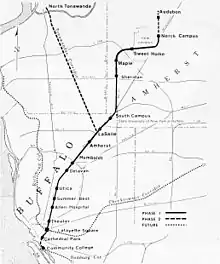
Despite the decline of Buffalo's industry and population over the next few decades, federal funds and a desire to revitalize downtown spurred the Niagara Frontier Transportation Authority, the IRC's successor, to construct the modern Metro Rail line, starting in 1979. It came amid a surge in light rail construction in mid-sized cities nationwide, as Denver, Portland, Sacramento, and San Jose also built systems at the same time.[6]
The line opened in stages: the surface portion opened on October 9, 1984,[7] while the subway opened as far as Amherst Street Station on May 20, 1985,[8] following an opening ceremony on May 18. The line was further extended to University Station, serving the University at Buffalo, on November 10, 1986, due to construction issues at LaSalle Station.[9] At the time of the start of construction, the line was intended to be the first line for an extensive heavy rail system that would spread throughout the city and suburbs. However, during the construction of the line and afterward, Buffalo's population declined significantly by approximately 55% from around 580,000 in 1950 to about 261,000 in 2010 and the new line's ridership was much lower than originally anticipated. The cost of the urban section was so high that no funding was available to extend the lines into the suburbs, including the Amherst campus of the University at Buffalo. Efforts to obtain funding for feeder lines have historically been met with little to no success.
Renovations and expansion
Although a centerpiece of the original line, the downtown transit mall did not live up to expectations. Because of poor traffic patterns on Main Street, some business groups occasionally called for the removal of the transit system so that they can return to normal vehicle traffic and curbside parking.
In 2008, Buffalo began a project to reintroduce cars to Main Street.[10] The project in question involved creating a shared trackbed/roadway with curbside parking, as well as the permanent closure of the Theater Station, which occurred on February 18, 2013. The closure of Theater Station meant that Fountain Plaza Station, located 546 feet (166 m) south in the 500 block of Main Street, now serves as the northern terminus of the Free Fare Zone. On January 23, 2015, after less than two years of construction, traffic was reintroduced to the 600 block of Main Street, between Tupper and Chippewa Streets, in the Theater District.[11][12] On December 15, 2015, traffic was reintroduced to the 500 block of Main Street, between Chippewa and Mohawk streets, in the Central Business District.
On January 9, 2017, then-Governor Andrew Cuomo announced in his State of the State address that funding would be secured for the Amherst and Cobblestone line extensions. If successful, this would be the first extension in the service's history.[13] Funding for an environmental review into the Amherst extension was approved in 2018. The study is expected to take between 24 and 30 months.[14]
Operations
Route
.jpg.webp)
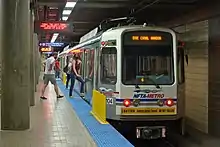
Metro Rail is a light rail transit (LRT) system as characterized by the American Public Transportation Association[15] although it shares many characteristics with "heavy rail" metro systems and could be considered a "light metro."[16] 80% of its track (5.2 miles (8.4 km)) is an underground subway with high-level platforms. This section has eight stations that are spaced fairly widely apart, comparable to subway systems elsewhere. This section is cut-and-cover from Allen/Medical Campus to Utica, then deep-bored from Delavan/Canisius College to University.
The remaining 20% of its track (1.2 miles (1.9 km)) are on the surface on Main Street in downtown Buffalo, which includes a brief underpass of Buffalo’s tallest building, the Seneca One Tower.[17] On the surface section, trains interact with automobile traffic from the theater district where it emerges from the tunnel until Mohawk Street where it reverts to a transit mall and at cross streets, where movements are governed by traffic signals. Catenary poles are spaced every 130 feet (40 m) to support the overhead electrical lines.[18] Metro Rail operates electric multiple-unit light rail vehicles (LRVs) in two-to-four car trains with power drawn from an overhead catenary system. Three-car trains are limited to rush hour and special events and four-car trains to special events.[17][19] The Buffalo trains join Philadelphia's SEPTA light rail cars as the only modern non-articulated LRVs operating in the United States.
Stations
| Name | Image | Type | Platform | Opened | Fare zone | Notes |
|---|---|---|---|---|---|---|
| University | .jpg.webp) |
Underground | Side | November 10, 1986 | Fare-paid zone | Formerly South Campus; renamed in September 2003. Serves the University at Buffalo South Campus. |
| LaSalle |  |
Serves Shoshone Park. | ||||
| Amherst Street |  |
Island | May 20, 1985 | Serves Buffalo Zoo. | ||
| Humboldt-Hospital | .jpg.webp) |
Side | Serves Sisters of Charity Hospital, Medaille College and Darwin D. Martin House. | |||
| Delavan/Canisius College | 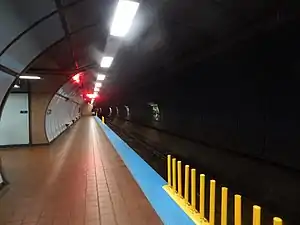 |
Formerly Delavan-College; renamed in September 2003. Serves Canisius College and Forest Lawn Cemetery. | ||||
| Utica |  |
Serves NFTA Transit Police Headquarters. | ||||
| Summer-Best |  |
Serves Theodore Roosevelt Inaugural National Historic Site and Kleinhans Music Hall. | ||||
| Allen/Medical Campus | 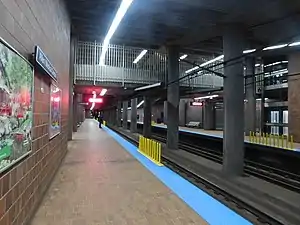 |
Formerly Allen-Hospital; renamed in September 2003. Serves Allentown Business District and Buffalo Niagara Medical Campus. | ||||
| Theater | 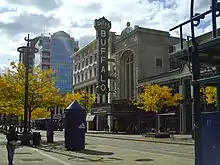 |
Street level | October 9, 1984 | Free fare zone | Permanently closed on February 18, 2013 to return automobile traffic to Main Street. | |
| Fountain Plaza | 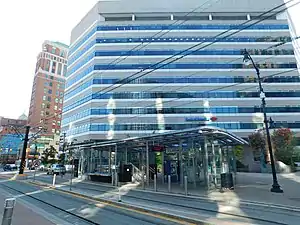 |
Formerly Huron. Serves the Chippewa Entertainment District. | ||||
| Lafayette Square | 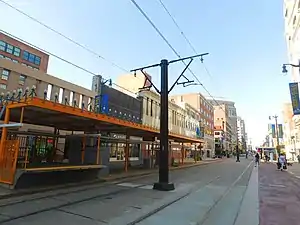 |
Serves Buffalo and Erie County Public Library, Buffalo Niagara Convention Center and offices in downtown Buffalo. | ||||
| Church | 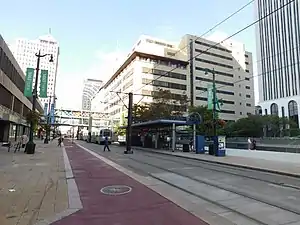 |
Serves offices in downtown Buffalo. | ||||
| Seneca |  |
Serves Sahlen Field, Seneca One Tower and other offices in downtown Buffalo. | ||||
| Erie Canal Harbor |
 |
Formerly Auditorium; renamed in September 2003. Serves Buffalo–Exchange Street station (Amtrak), LECOM Harborcenter and Canalside. There are plans to rebuild and rename the station "Canalside".[20] | ||||
| Special Events | 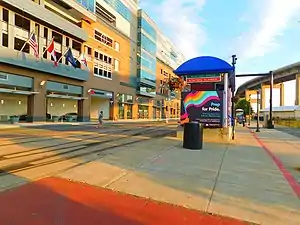 |
1985 | Formerly Arena. Serves KeyBank Center. | |||
| DL&W | 2024 | NFTA will spend $52 million for upgrades. Once completed, will replace Special Events station and serve KeyBank Center and Canalside. |
Fares
Fares are collected through a proof-of-payment system, enforced through random ticket inspections. Travel is free on the above ground portion of the system.[21] Regular fare is $2; various passes are also available for sale. All stations have ticket machines.[22] Due to the COVID-19 pandemic, NFTA temporarily suspended fare collection starting in late March 2020. Fare collection resumed on June 29, 2020.[23]
Schedules
Metro Rail runs as follows: Monday-Friday from 5:10 am-12:50 am, Saturdays from 7:05 am-12:50 am and Sundays and holidays from 8:00 am-11:50 pm (although most bus service is available until approximately 12:30 am). Trains run as often as once every ten minutes at rush hour and generally no less often than once every twenty minutes. In July 2008, the NFTA reported that the passenger count "eclipsed the previous year's tally by 23%."[24] As a result, the following September, the NFTA implemented an earlier start for the weekday schedule in response to an 11% increase in ridership over eight months of growth.
Ridership
Annual ridership statistics are from the Federal Transit Administration's National Transit Database, which contains data from 1996 to 2011:[25]
Plans for expansion
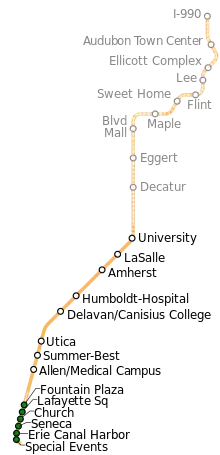
Buffalo Metro Rail was ranked 25th in the nation in light rail daily ridership service in 2013, with 5,058,300 passengers. However, it is noted that the line currently lacks extended branches to the suburbs, being confined to the city limits of Buffalo. One group, the Citizens Regional Transit Corporation (CRTC), advocates for expansion.[26] As indicated in its statement, the CRTC seeks to educate the public, public officials, their authorities, and agencies in the Buffalo-Niagara region about the benefits of a comprehensive transportation system including an expanded Metro Rail. In April 2011, the group stated that the 600 block of Main Street, which has Shea's Performing Arts Center along with hotels and bars, should be converted into a mixed automobile and rail system.[27] The 600 block was re-opened to automobile traffic in 2015.
In December 2012, the NFTA announced it had secured funding of $1.6 million to commission a study in 2013 of bus and rail access to University at Buffalo's North Campus. If a rail project were to be approved, the system would be running in 7–10 years. On February 28, 2013, it was announced that a group consisting of representatives from the Buffalo Niagara Medical Campus, planners from the City of Buffalo, the Buffalo Sabres and NFTA are working on a plan to extend the southern terminus of the rail line just beyond the NFTA rail yard at the DL&W Terminal to a new parking garage being built near the Medical Campus.[28]
Amherst corridor
In the December 4, 2006, edition of The Spectrum, a publication of the University at Buffalo (UB), it was announced that then-school president John B. Simpson was planning to get a project underway that would connect UB's North, South and downtown campuses via a transportation system. The proposed systems included a subway, trolley or light rail. A study that was published in 2014 detailed four alternatives chosen for the corridor, including a light rail corridor and three bus rapid transit corridors. The light rail corridor would extend from a turnout at University station, head north to Niagara Falls Boulevard past the Boulevard Mall, turn to Sweet Home Road, enter the University at Buffalo North Campus and parallel Interstate 990 ending at the Crosspoint Business Park in Getzville.[29]
Planning and funding is currently underway for a northbound Niagara Falls Boulevard extension to the University at Buffalo North Campus.[30] As of 2019, the proposed turnout tunnel to Niagara Falls Boulevard has been shortened, increasing the overall length of the street-side light rail portion of the route, and a new tunnel has been added to the design near I-290. In addition, the chosen corridor would parallel Audubon Boulevard and end at a park-and-ride after passing under I-990, rather than continuing to the Crosspoint Business Park.[31] The NFTA has also released a finalized scoping report and a draft environmental study report,[32] and has been receiving community input on the project.[33][34]
Airport corridor
The Airport corridor would begin in Downtown Buffalo, near Church station and continue in an easterly direction in/out Division Streets, diagonally in a northeastern direction near Jefferson Avenue toward the Buffalo Central Terminal, cross Broadway and then continue eastbound in its private right-of-way to the Thruway Plaza, Walden Galleria and Buffalo-Niagara International Airport.
Tonawandas corridor
The Tonawandas corridor would operate from LaSalle station northwesterly to the city of Tonawanda using the abandoned Erie Railroad tracks. The NFTA purchased 12 Presidents' Conference Committee (PCC) streetcars in the 1980s to serve the Tonawanda turn-out, a proposed Metro Rail extension to Tonawanda and North Tonawanda. These cars were built by the St. Louis Car Company and acquired by Cleveland, Ohio's Greater Cleveland Regional Transit Authority second-hand in 1953. It was determined after initial trial runs that the PCCs were too wide for existing station platforms and the plan was abandoned. The PCCs were sold to the Brooklyn Historic Railway Association (BHRA) and scrapped in 2003 when the BHRA folded.
DL&W Terminal renewal
NFTA is repurposing the DL&W Terminal with plans for a new indoor Metro Rail DL&W Station on the first floor of the terminal, on the Buffalo River side, with direct Buffalo Bricks Walkway access to Canalside,[35] with staircases and escalators to the second floor of the terminal and the elimination of the Special Events Station. On the second floor, NFTA has assigned private developer Savarino Cos, to plan the $30 million redevelopment[36] of the enormous amount of first and second floor floor-space, along with direct access to the KeyBank Center,[37][38] with a $3 million sheltered pedestrian skybridge from the second floor, near the intersection of South Park Avenue and Main Street, from the terminal to the KeyBank Center, with $2 million of that financed with federal aid.[39][40]
Rolling stock
| Buffalo LRV | |
|---|---|
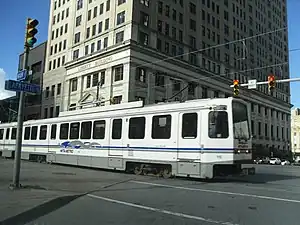 | |
.jpg.webp) | |
| In service | 1984−present |
| Manufacturer | Tokyu Car Corporation (now J-TREC) |
| Constructed | 1983 |
| Entered service | 1984 |
| Refurbished | 2012–present |
| Number in service | 27 |
| Formation | 2 to 4–car sets |
| Fleet numbers | 101–127 |
| Capacity | 210 |
| Operator(s) | Niagara Frontier Transportation Authority |
| Depot(s) | NFTA Rail Maintenance Yard |
| Line(s) served | Main Street |
| Specifications | |
| Car length | 66 ft 10 in (20,371 mm) |
| Width | 8 ft 7 in (2,616 mm) |
| Height | 11 ft 2+23⁄32 in (3,422 mm) |
| Maximum speed | 50 mph (80 km/h) |
| Traction system | Chopper control |
| Traction motors | 4 × 138 hp (103 kW) DC motors |
| Power output | 553 hp (412 kW) |
| Acceleration | 3.0 mph/s (4.8 km/(h⋅s)) |
| Deceleration |
|
| Electric system(s) | Overhead line, 650 V DC |
| Current collector(s) | Pantograph |
| AAR wheel arrangement | Bo-Bo |
| Coupling system | Scharfenberg coupler |
| Track gauge | 4 ft 8+1⁄2 in (1,435 mm) standard gauge |
| Notes/references | |
| [18] | |
The NFTA has a fleet of 27 (originally 29) rigid-bodied (non-articulated) LRVs for the Metro Rail system, numbered sequentially from 101 to 127. They were built in 1983 by Tokyu Car Corporation (now known as Japan Transport Engineering Company).[18] The cars' body shell design is notably similar to that of the earlier articulated US Standard Light Rail Vehicle, whose shells were also fabricated by Tokyu Car Corp. for Boeing Vertol. The cars have a maximum service speed of 50 miles per hour (80 km/h), but trains run at 15 miles per hour (24 km/h) in the above-ground section of the line.[18] There are three sliding doors on each side of each LRV; these doors can be opened by passengers by push buttons on the outside wall of the train when trains are stopped at stations on the above-ground section of the line.[18] However, in practice, train operators typically open all doors and extend all the retractable staircases at all above-stations. The NFTA acquired twelve PCC streetcars from the Greater Cleveland Regional Transit Authority in 1990 for service on the never-built Tonawandas branch. They were later sold to the Brooklyn Historic Railway Association in 2003.[41]
Rehabilitation
In May 2006, it was announced that all of the LRVs would be rehabilitated by AnsaldoBreda. The rehabilitation featured many improvements, including enhanced video monitoring of the railcar interiors, an upgraded braking system, rebuilt HVAC systems, rebuilt door systems, a new interior closely representing the agency's new look, upgraded propulsion systems and repairs to the body shells. In addition, the rail cars were to receive new monitoring systems, an automated announcement system calling out stations, new door chimes and interior/exterior LED signage to replace existing roll signs. The total project cost was estimated at $40 million for rehabilitation of the 27 cars.[42]
Because the refurbished cars have new car-to-car communications equipment, they are not compatible with unrefurbished cars and cannot run with them on the same line.[43] The project originally planned to use SuperSteel's manufacturing facilities in Schenectady, New York, for the overhaul. However, due to the loss of orders and a dip in the economy, SuperSteel closed the facility in April 2009. The closure cost 175 jobs and delayed the rehabilitation.[44] The project later was moved to Gray Manufacturing Industries, located in Hornell, New York.[45] The first two cars were due back in revenue service in July 2010.[46]
After a lengthy delay, which put the project years behind the original schedule, the first two cars (fleet numbers 114 and 123) were returned to service on March 9, 2012. However, the cost of refurbishment per car had since gone up and now averaged $1.7 million per car with a total cost of $45 million to complete all cars in the fleet. Three more cars (numbers 110, 111 and 126) were sent out and were expected to be completed before the end of 2012, but did not return to service until the fall of 2013.[47] On October 1, 2014, car 113 also returned to service. Since then, 20 more cars (fleet numbers 101, 102, 103, 104, 105, 106, 108, 109, 112, 115, 116, 117, 118, 119, 120, 121, 122, 124, 125 and 127) have returned to service, bringing the total number of refurbished rail cars to 26 as of February 1, 2022. It is not known what happened to car 107, which has not been refurbished.
Notes
- "2014-2015 Annual Performance Report" (PDF). Niagara Frontier Transportation Authority. Archived from the original (PDF) on September 15, 2015. Retrieved October 16, 2015.
- "Transit Ridership Report Second Quarter 2023" (PDF). American Public Transportation Association. September 13, 2023. Retrieved September 21, 2023.
- "Transit Ridership Report Fourth Quarter 2022" (PDF). American Public Transportation Association. March 1, 2023. Retrieved March 29, 2023.
- Buffalo’s Historic Streetcars and Buses, D. David Bregger, Arcadia Pub., c2008. ISBN 978-0-7385-5750-2
- The Last Decade of Buffalo Streetcars, date unknown, Harold Ahlstrom (National Railway Historical Society, Inc.
- Minister, R. David; Clarke, David J. (March 30, 1982). "Factors to Consider in Designing a Joint Bus-Light Rail Transit Mall" (PDF). Transportation Research Board.
- Gargan, Edward A. (October 10, 1984). "Buffalo Trolley Line Clangs to a Start". The New York Times. Archived from the original on December 22, 2015. Retrieved October 17, 2015.
- Sebree, Mac (August 1985). "Interurbans Newsletter". Pacific RailNews. p. 38. Archived from the original on July 28, 2014. Retrieved February 13, 2017.
- Edens, John (December 1, 2011). "25 years ago: South Campus rapid transit station opens". UB Reporter. Archived from the original on March 4, 2016. Retrieved October 17, 2015.
- "Return of Vehicular Traffic to Main Street". Buffalo Place Inc. Archived from the original on July 25, 2008. Retrieved February 3, 2015.
- Schulman, Susan (January 23, 2015). "Vehicular traffic is set to return to 600 block of Main Street in Buffalo". The Buffalo News. Archived from the original on February 3, 2015. Retrieved February 3, 2015.
- McCarthy, Robert J. (January 24, 2013). "Metro Rail's Theater Station set for last use Feb. 17". The Buffalo News. Archived from the original on October 18, 2015. Retrieved October 18, 2015.
- "Local leaders praise $500 million plan to keep up Buffalo's momentum". The Buffalo News. January 9, 2017. Archived from the original on January 11, 2017. Retrieved January 10, 2017.
- Morretti, Luke (February 22, 2018). "Metro Rail expansion to Amherst moves forward". WIVB. Archived from the original on June 28, 2018. Retrieved June 28, 2018.
- "U.S. Light Rail Transit System Links". American Public Transportation Association. Archived from the original on December 10, 2008. Retrieved September 24, 2008.
- Middleton 2003, p. 152
- "world.nycsubway.org: Buffalo, New York". Nycsubway.org. July 23, 2012. Retrieved August 17, 2013.
- "City Of Buffalo Main Street Multi-Modal Access And Revitalization Project: Environmental Assessment" (PDF). Niagara Frontier Transportation Authority (NFTA). April 2009. Archived from the original (PDF) on 2018-06-25. Retrieved 2014-02-18.
- Karen Wilson (April 16, 2009). "FTA NOISE MODELING WORKSHEETS AND DETAILED METHODOLOGY" (PDF). Niagara Frontier Transportation Authority (NFTA). Archived from the original (PDF) on March 4, 2016. Retrieved June 11, 2014.
- "New Metro Rail station coming to Canalside". November 22, 2021.
- "How to Ride". Niagara Frontier Transportation Authority. Archived from the original on October 26, 2015. Retrieved October 17, 2015.
- "Metro Fares". Niagara Frontier Transportation Authority. Archived from the original on October 26, 2015. Retrieved October 17, 2015.
- "NFTA-Metro COVID-19 FAQ". Niagara Frontier Transportation Authority. Retrieved 1 July 2020.
- Sharon Linstedt (August 21, 2008). "Metro Rail to add earlier train run". The Buffalo News. Archived from the original on June 13, 2016. Retrieved August 24, 2008.
- "The National Transit Database Publications Page". National Transit Database. Archived from the original on January 31, 2015. Retrieved December 10, 2014.
- "Citizens for Regional Transit – Expand Metro Rail, the world's greenest mass transit!". citizenstransit.org. Archived from the original on October 3, 2019. Retrieved February 2, 2020.
- Gifford, Gladys; Doug Funke (March 24, 2011). "Let's Do Cars on Main Street the Right Way!!" (PDF). Archived (PDF) from the original on July 17, 2011. Retrieved April 28, 2011.
- "Metro Rail extension eyed to shuttle workers to Medical Campus, Buffalo News". Archived from the original on June 13, 2016. Retrieved February 2, 2020.
- "Metro Amherst-Buffalo Corridor" (PDF). NFTA. Archived (PDF) from the original on July 8, 2015. Retrieved June 14, 2015.
- Popiolkowski, Joseph (April 18, 2017). "Plan for Metro Rail extension to Amherst coming into focus". The Buffalo News. Archived from the original on September 20, 2017. Retrieved September 19, 2017.
- "About – NFTA Metro". nftametrorailexpansion.com. Archived from the original on 2020-02-02. Retrieved 2020-02-02.
- Expansion Project Final Scoping Report (PDF). nftametrorailexension.com (Report). May 2019.
- Dudzik, Kelly (2019-09-24). "NFTA gets feedback on Metro Rail expansion plans". WGRZ. Retrieved 2020-02-01.
- Melamed, Gilad (2019-09-25). "Neighbors in the Northtowns voice opinions on Metro Rail expansion with the NFTA". WKBW. Archived from the original on September 26, 2019. Retrieved 2020-02-01.
- "Buffalo Bricks newly designed layout". 29 June 2013.
- "State's $30 million grant could turn DL&W dreams into 2025 reality". May 4, 2022.
- "See latest on plans to turn DL&W terminal into Metro Rail station". May 4, 2021.
- "DL&W Terminal as 'compelling public space' if properly restored". October 16, 2021.
- "Bring Sky Bridge Back to DL&W Project". November 23, 2021.
- "Skybridge from DL&W Terminal to KeyBank Center among Buffalo projects to be financed by federal aid". March 14, 2022.
- Bregger 2008, p. 121
- Fink, James (June 22, 2009). "Park-and-ride likely to be saved". Buffalo Business First. Archived from the original on July 9, 2015. Retrieved October 18, 2015.
- McCarthy, Robert J. (March 9, 2012). "Refurbished Metro cars re-enter rail service". The Buffalo News. Archived from the original on March 13, 2012. Retrieved April 14, 2014.
- Lamendola, Michael (June 26, 2009). "Rail car manufacturer offers to buy vacant Super Steel site". The Daily Gazette. Archived from the original on July 8, 2015. Retrieved August 17, 2013.
- Penny Dessena (September 29, 2008). "Gray Manufacturing Industries, LLC" (PDF). Archived (PDF) from the original on November 15, 2014. Retrieved June 11, 2014.
- McCarthy, Robert J. (February 16, 2010). "Metro Rail trains undergo a rebirth". The Buffalo News. Archived from the original on March 12, 2010. Retrieved July 18, 2010.
- "NFTA Debuts New, Modern Metro Rail Cars". Archived from the original on February 9, 2013. Retrieved April 16, 2012.
References
- Bregger, D. David (2008). Buffalo's Historic Streetcars and Buses. Images of America. Charleston, SC: Arcadia Publishing. ISBN 978-0-7385-5750-2.
- Middleton, William D. (2003). Metropolitan Railways: Rapid Transit in America. Bloomington, IN: Indiana University Press. ISBN 0-253-34179-5.
